Hydrangea serrata - description of the plant
Hydrangea serrata (Hydrangea serrata) conquers with its bright inflorescences and the ability to change color depending on the composition of the soil. She needs regular care, but it is not particularly difficult. This shrub is grown in regions with warm and temperate climates, sheltering and insulating for the winter.
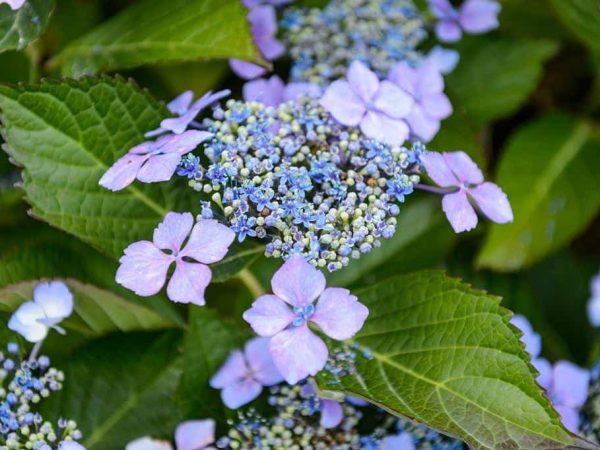
Serrated hydrangea varieties photo
General characteristics
Hydrangea is an ancient flower that grew thousands of years ago in Asia (Japan, China) and America (California, Oregon, Omaha agglomeration, Alaska). She came to Europe in the 18th century.
The serrated variety differs from others in the notches at the edges of the leaves and the characteristic thyroid or spherical inflorescence, similar to a cap.
The shrub reaches a height of 1-1.5 m. A fairly strong trunk is hidden behind abundant green foliage. The root system is superficial, well-branched.
Interestingly, the colors and shades of hydrangeas can change depending on the weak or strong acidity of the soil.
Flowering usually begins in July, continuing until late August or early September (sometimes until October).
Popular varieties
Hydrangea serrated conquers with a variety of varieties. Many of them have not only spectacular inflorescences, but also original decorative leaves (golden, purple, purple).
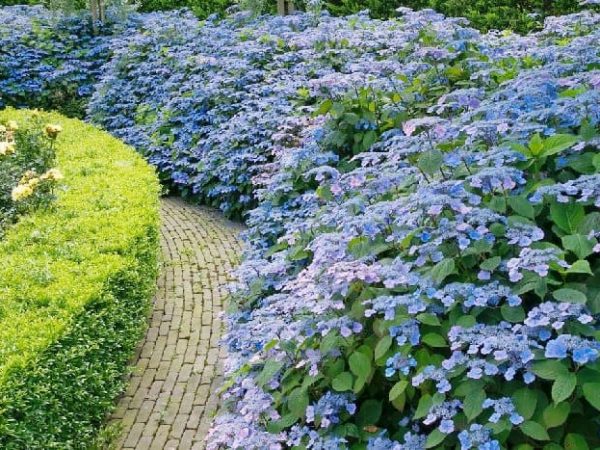
Hydrangea bluebird description
Popular varieties include: Bluebird, Preciosa, Koreana, Golden Sunline, Whirl, Intermedia, Avelrose, Santiago.
Bluebird or Bluebird
This variety is distinguished by blue, purple or lilac inflorescences. In the center of it there are small flowers, and along the perimeter there are large (sterile) ones.
They acquire a deep blue hue on acidic soils. The height of the shrub is about 150 cm. Frost resistance is quite high (up to -30 ° C).
Preziosa
The hydrangea has dense inflorescences that look like caps. The flowers are yellowish at first, but over time they become pink, and by the fall - richly crimson.
The height of the bush is 100-130 cm. The leaves are dark green, finely serrated, oval with a sharp tip. Average winter hardiness (up to -22 ° C).
Koreana
The shrub grows up to 150 cm. The inflorescences are in the form of a shield with a diameter of 8-9 cm. The flowers can be white, pinkish, lilac or blue, depending on the acidity of the soil.
It blooms for a long time: from early July to mid-September.
Golden Sunlight
The variety is distinguished by golden yellow leaves, which acquire a greenish tint over time. The stems are claret, the inflorescences are lilac-pink.
Small flowers are located in the center, framed by several large sterile flowers. The bush reaches a height of 100 cm. Golden Sunlight blooms all summer, and sometimes it also captures September.
Veerle or Veerle
It reaches a height of just over 1m.Possesses thyroid inflorescences: on neutral soils - pink, on acidic - blue-lilac. Green leaves in summer turn red-purple by autumn. Flowering takes place from June to early September.
Intermedia
A compact shrub no more than 1 m in height. It is distinguished by shiny dark green leaves with jagged edges and a sharp tip. Inflorescences are flat, somewhat loose.
The central flowers are lilac-pink, the lateral ones are white, with pinkish wavy edges. Winter hardiness of the variety is medium (up to -23 ° C).
Avelrouz
A short bush has umbrella-shaped inflorescences: pink - on neutral soils, purple - on acidic soils. Shrub height - up to 1 m.
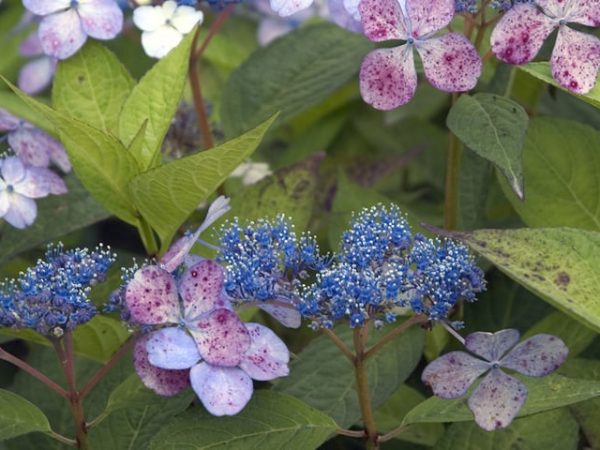
Hydrangea serrated photo and description
Differs in spectacular green-lilac leaves, in autumn - purple-red. Blooms all summer. Due to the average frost resistance, it requires shelter for the winter.
Santiago
A spectacular variety that blooms from June to early October. The bush is compact (80-100 cm), but well branched. Lush pink inflorescences consist of small flowers in the center and large ones around the perimeter. The latter are distinguished by multi-layered petals and resemble miniature roses. Green foliage has a bronze tint in summer and turns purple in autumn.
Landing rules
You can plant a hydrangea in partial shade or in an open place (subject to diffused sunlight). In direct sunlight, the inflorescences can droop.
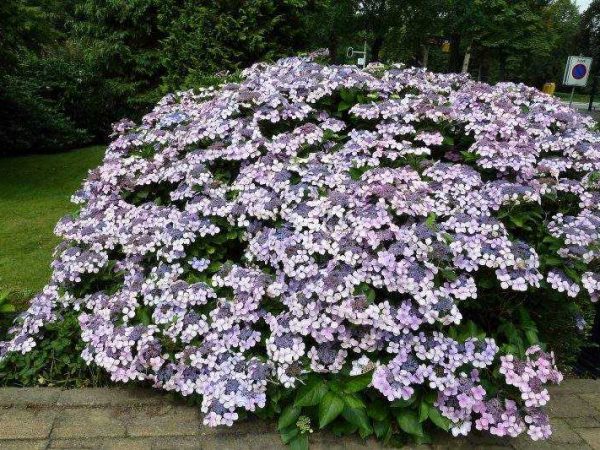
Hydrangea serrated care
Optimal terms:
- In spring - from the second half of April to the beginning of May;
- Autumn - mid-September.
Suitable soil is neutral or acidic, sufficiently loose and moisture-permeable.
Landing technology:
- A hole is dug to a depth of 50-60 cm (and of the same diameter).
- The top layer of earth is mixed with humus, peat and sand, urea is added.
- If necessary (on heavy soils), drainage from perlite or small pebbles is laid on the bottom.
- Fill the hole in one third with nutritious soil.
- The plant is placed, covered and tamped, leaving the root collar at ground level.
- Water and mulch abundantly (with sawdust, peat chips, wood chips or bark).
Care rules
Hydrangea is a moisture-loving plant that needs frequent watering. In addition, during the flowering period, care for the near-stem circle and moderate feeding are necessary.
In order for the bush to grow quickly in the spring, you need to competently prepare it for wintering: fertilize, cut and insulate.
During flowering
Hydrangeas need regular watering, during dry periods - daily. The soil should not be overmoistened, and at the same time, it should always be moderately moist. During budding and after flowering, the bush is fertilized with a solution of humus and peat.
A good top dressing would be a weekly renewal of organic mulch - compost and peat crumbs. If the shrub grows in an open place, on hot days it needs midday shading.
Preparing for winter
In the fall, pruning and shaping of the bush is carried out - for sanitary purposes and to stimulate future flowering. With a sharp disinfected pruner, the branches are cut into 2 or 3 buds. They feed the hydrangea with a phosphorus-potassium composition, spud, mulch with peat.
The stems are tied with a rope, wrapped in burlap, covered with spruce branches, and on top with polyethylene (securely fastened). In anticipation of severe frosts, the bush is bent to the ground, covered with bricks, and insulated with old blankets.
Diseases and pests
The serrated hydrangea is resistant to disease, but, of course, not immune from them. Sometimes it can be affected by chlorosis and powdery mildew.
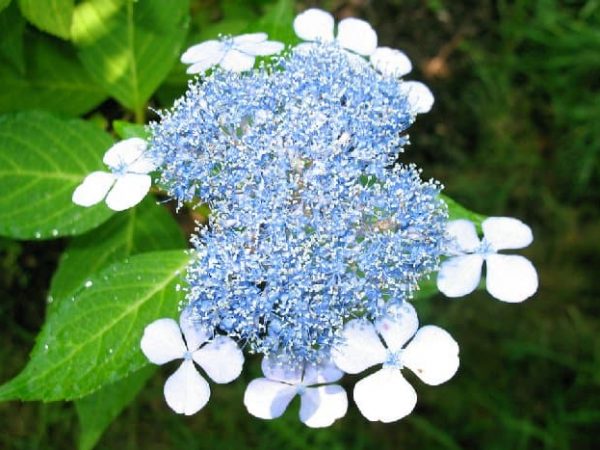
Hydrangea serrated planting and care in the open field
The best prevention will be complete care: loosening, weeding, mulching, pruning, the correct watering and feeding regime. You can process the bushes with copper and iron vitriol, Skor, Topaz, Fundazol.
Of the pests, slugs and snails are at risk, as well as aphids and spider mites.
To avoid damage to the leaves by mollusks (they gnaw unaesthetic holes), you need to water the plants in the morning, directing the stream of water strictly to the root. In case of an invasion of insects, the bush is washed with soapy water, in serious cases, insecticides and acaricides are used.
Gardeners reviews
Many gardeners are fond of hydrangeas and often planted serrated varieties in the garden.
Judging by most reviews, the shrub requires regular care, especially pre-winter preparation. Although, some growers in regions with mild and snowy winters do not shelter it at all.
It has been noticed that the bushes planted in full shade build up their green mass well, but they bloom poorly. In rainy seasons, the inflorescences are larger and more lush. To "tint" flowers in blue and blue shades, gardeners acidify the soil with aluminum-potassium alum, citric and succinic acids, and sour peat.

